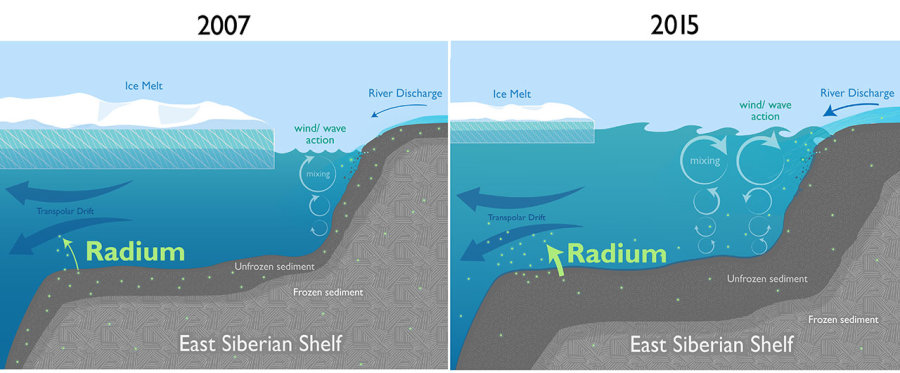SOURCE: Science Daily and Woods Hole Oceanographic Institution
DATE: January 3, 2018
SNIP: Scientists have found surprising evidence of rapid climate change in the Arctic: In the middle of the Arctic Ocean near the North Pole, they discovered that the levels of radium-228 have almost doubled over the last decade.
The finding indicates that large-scale changes are happening along the coast—because the source of the radium is the land and shallow continental shelves surrounding the ocean. These coastal changes, in turn, could also be delivering more nutrients, carbon, and other chemicals into the Arctic Ocean and lead to dramatic impacts on Arctic food webs and animal populations.
The research team, led by Woods Hole Oceanographic Institution (WHOI), suspects that melting sea ice has left more open water near the coast for winds to create waves. The wave action reaches down to the shallow shelves and stirs up sediments, releasing radium that is carried to the surface and away into the open ocean. The same mechanism would likely also mobilize and deliver more nutrients, carbon, and other chemicals into the Arctic Ocean, fueling the growth of plankton at the bottom of the food chain. That, in turn, could have significant impacts on fish and marine mammals and change the Arctic ecosystem.
The scientists theorize that a warming Arctic environment has reduced sea ice cover, allowing for more wave action that stirs up sediments and mobilizes more radium.
More wave action can also cause more coastline erosion, adding more terrestrial sediment into the ocean. Warming temperatures can thaw permafrost, liberating more material into the ocean, and increasing river and groundwater runoff can carry more radium, nutrients, carbon, and other material into the Arctic.
The study was published Jan. 3, 2018, in the journal Science Advances.

